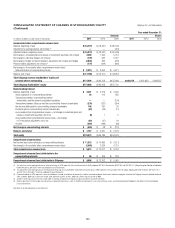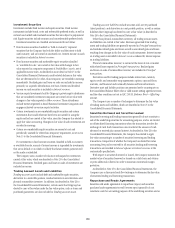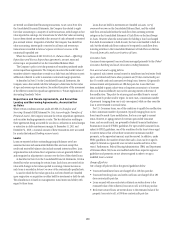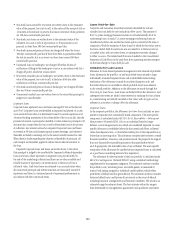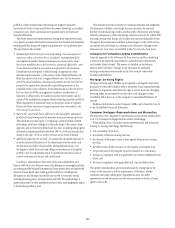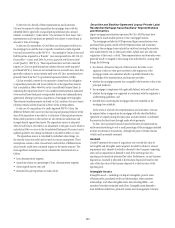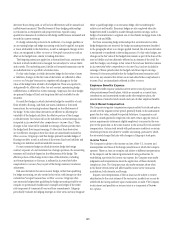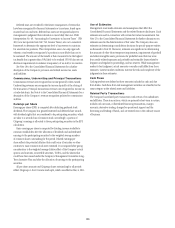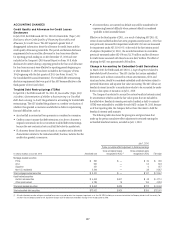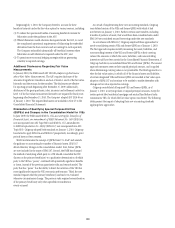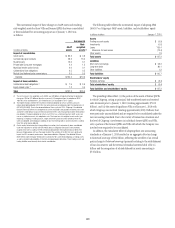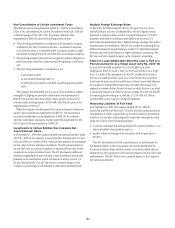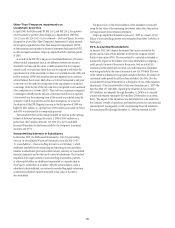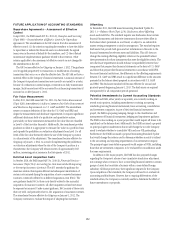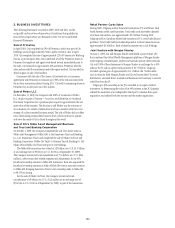Citibank 2011 Annual Report Download - page 167
Download and view the complete annual report
Please find page 167 of the 2011 Citibank annual report below. You can navigate through the pages in the report by either clicking on the pages listed below, or by using the keyword search tool below to find specific information within the annual report.145
derivative that is being used, as well as how effectiveness will be assessed and
ineffectiveness measured. The effectiveness of these hedging relationships
is evaluated on a retrospective and prospective basis, typically using
quantitative measures of correlation with hedge ineffectiveness measured and
recorded in current earnings.
If a hedge relationship is found to be ineffective, it no longer qualifies as
an accounting hedge and hedge accounting would not be applied. Any gains
or losses attributable to the derivatives, as well as subsequent changes in fair
value, are recognized in Other revenue or Principal transactions with no
offset on the hedged item, similar to trading derivatives.
The foregoing criteria are applied on a decentralized basis, consistent with
the level at which market risk is managed, but are subject to various limits
and controls. The underlying asset, liability or forecasted transaction may be
an individual item or a portfolio of similar items.
For fair value hedges, in which derivatives hedge the fair value of assets
or liabilities, changes in the fair value of derivatives are reflected in Other
revenue or Principal transactions, together with changes in the fair
value of the hedged item related to the hedged risk. These are expected to,
and generally do, offset each other. Any net amount, representing hedge
ineffectiveness, is reflected in current earnings. Citigroup’s fair value hedges
are primarily hedges of fixed-rate long-term debt and available-for-sale
securities.
For cash flow hedges, in which derivatives hedge the variability of cash
flows related to floating- and fixed-rate assets, liabilities or forecasted
transactions, the accounting treatment depends on the effectiveness of
the hedge. To the extent these derivatives are effective in offsetting the
variability of the hedged cash flows, the effective portion of the changes
in the derivatives’ fair values will not be included in current earnings, but
is reported in Accumulated other comprehensive income (loss). These
changes in fair value will be included in earnings of future periods when
the hedged cash flows impact earnings. To the extent these derivatives
are not effective, changes in their fair values are immediately included in
Other revenue. Citigroup’s cash flow hedges primarily include hedges of
floating-rate debt, as well as rollovers of short-term fixed-rate liabilities and
floating-rate liabilities and forecasted debt issuances.
For net investment hedges in which derivatives hedge the foreign
currency exposure of a net investment in a foreign operation, the accounting
treatment will similarly depend on the effectiveness of the hedge. The
effective portion of the change in fair value of the derivative, including
any forward premium or discount, is reflected in Accumulated other
comprehensive income (loss) as part of the foreign currency translation
adjustment.
End-user derivatives that are economic hedges, rather than qualifying
for hedge accounting, are also carried at fair value, with changes in value
included in Principal transactions or Other revenue. Citigroup often
uses economic hedges when qualifying for hedge accounting would be too
complex or operationally burdensome; examples are hedges of the credit
risk component of commercial loans and loan commitments. Citigroup
periodically evaluates its hedging strategies in other areas and may designate
either a qualifying hedge or an economic hedge, after considering the
relative cost and benefits. Economic hedges are also employed when the
hedged item itself is marked to market through current earnings, such as
hedges of commitments to originate one-to-four-family mortgage loans to be
held for sale and MSRs.
For those accounting hedge relationships that are terminated or when
hedge designations are removed, the hedge accounting treatment described
in the paragraphs above is no longer applied. Instead, the end-user derivative
is terminated or transferred to the trading account. For fair value hedges, any
changes in the fair value of the hedged item remain as part of the basis of the
asset or liability and are ultimately reflected as an element of the yield. For
cash flow hedges, any changes in fair value of the end-user derivative remain
in Accumulated other comprehensive income (loss) and are included in
earnings of future periods when the hedged cash flows impact earnings.
However, if it becomes probable that the hedged forecasted transaction will
not occur, any amounts that remain in Accumulated other comprehensive
income (loss) are immediately reflected in Other revenue.
Employee Benefits Expense
Employee benefits expense includes current service costs of pension and
other postretirement benefit plans, which are accrued on a current basis,
contributions and unrestricted awards under other employee plans, the
amortization of restricted stock awards and costs of other employee benefits.
Stock-Based Compensation
The Company recognizes compensation expense related to stock and option
awards over the requisite service period, generally based on the instruments’
grant date fair value, reduced by expected forfeitures. Compensation cost
related to awards granted to employees who meet certain age plus years-of-
service requirements (retirement eligible employees) is accrued in the year
prior to the grant date, in the same manner as the accrual for cash incentive
compensation. Certain stock awards with performance conditions or certain
clawback provisions are subject to variable accounting, pursuant to which
the associated charges fluctuate with changes in Citigroup’s stock price.
Income Taxes
The Company is subject to the income tax laws of the U.S., its states and
municipalities and those of the foreign jurisdictions in which the Company
operates. These tax laws are complex and subject to different interpretations
by the taxpayer and the relevant governmental taxing authorities. In
establishing a provision for income tax expense, the Company must make
judgments and interpretations about the application of these inherently
complex tax laws. The Company must also make estimates about when
in the future certain items will affect taxable income in the various tax
jurisdictions, both domestic and foreign.
Disputes over interpretations of the tax laws may be subject to review/
adjudication by the court systems of the various tax jurisdictions or may be
settled with the taxing authority upon examination or audit. The Company
treats interest and penalties on income taxes as a component of Income
tax expense.


